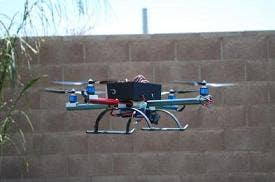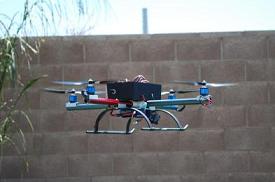Flying Drones for Your Home from DIY Drones (Video)

Share
So apparently building a military style drone is a do-it-yourself project now. DIY Drones is an online community that helps the unmanned aerial vehicle (UAV) enthusiast construct their own flying gizmos in their home. It's the brainchild of Chris Anderson, Wired's Editor in Chief. Complete with store, forums, blogs, and lots of helpful instructions, DIY Drones is the place to go if you want your own UAV to buzz your neighbor's cat. They've got some impressive hardware, and it's all open source. That's right, you can build, modify, refine, and share anything you build from DIY Drones. We've got some great videos of these UAVs in action, check them out after the break.
The armed forces of the world are relying increasingly upon UAVs to gather information in the field. The US military has so many drones in the air they're having a hard time processing all the data. These UAVs are going to get more numerous and easier to control. We've already seen one military drone that will be controllable via iPhone. Funny thing is, there's also a commercial equivalent of that unarmed UAV which is almost as sophisticated as the military one. That's why these amateur DIY Drone projects really caught my eye. No, they aren't military grade, but its amazing to see the open source hardware version of a military technology. Many of these drones can travel fairly long distances and altitudes, they have GPS guidance, they can fly unaided, some are equipped with cameras...these things are seriously cool. I'm not the only one who thinks so. While DIY Drones has only been around since 2007, they're already one of the dozen or so open source hardware collectives with revenues around $1 million a year.
Of course, the majority of projects on DIY Drones aren't made to impress so much as they are made to include. Chris Anderson has really aimed at providing access to some of the cheapest, easiest to build, and easiest to manage UAVs out there. He wants to bring robotics to the masses...and to the air. That's really great. Having a range of projects, a variety of entry points, is very appealing. Newcomers can plop down $100 and get a really cool aircraft to fly around with their kids. Serious enthusiasts can tap into the wider open source hardware community and help improve and refine the quality of these UAVs.
One of the more interesting aircraft at DIY Drones is the BlimpDuino. It's a flying balloon with an Arduino board controlling its propulsion and navigation. You can buy a complete kit for just $90:
For those who like more traditional craft, DIY Drone has plenty of airplanes as well. And these aren't simply model craft - they have autopilots, GPS tracking, and lots of other computerized/robotic components. I was really impressed by Anderson's UAV he built using Lego Mindstorms to enable its autopilot. Pretty cool:
Be Part of the Future
Sign up to receive top stories about groundbreaking technologies and visionary thinkers from SingularityHub.


Anderson gave a great speech at Maker Faire 2009 that gives an overview of DIY Drones. At 27 minutes it's a little long but worth a watch if you're thinking of getting into amateur UAV construction. That video is no longer online, but check out this short 4 minute video:
Open source is all about granting access to everyone. Sometimes that access is aimed at accelerating research (as with Willow Garage and ROS), but sometimes that access is aimed at simply allowing more people to participate. That's what DIY Drones really seems to be about. With a limited budget, extra time on the weekends, and a lot enthusiasm, anyone can join in the robotic revolution by building and commanding their own aircraft. That's very appealing, and DIY Drones may help build interest in the growing field of UAVs. We'll need that interest and expertise to fuel continuing innovation in what is growing to be one of the dominate technologies in the modern military. We'll also need that expertise when the robots take over and we have to fight for our lives against Air Penguins.
[image credit: DIYDrones]
[source: DIYDrones, Chris Anderson Blog at DIYDrones]
Related Articles

These Robots Are the Size of Single Cells and Cost Just a Penny Apiece

In Wild Experiment, Surgeon Uses Robot to Remove Blood Clot in Brain 4,000 Miles Away

A Squishy New Robotic ‘Eye’ Automatically Focuses Like Our Own
What we’re reading
